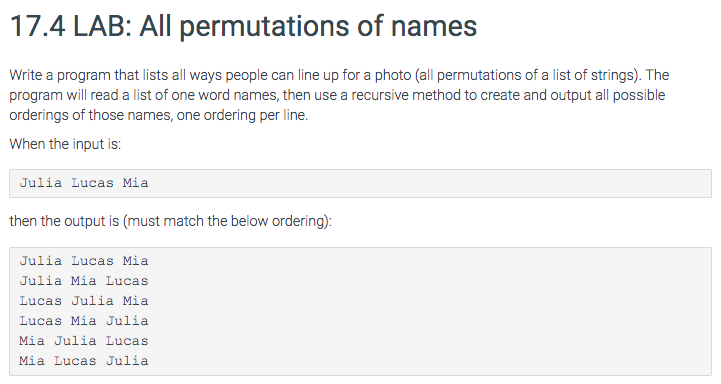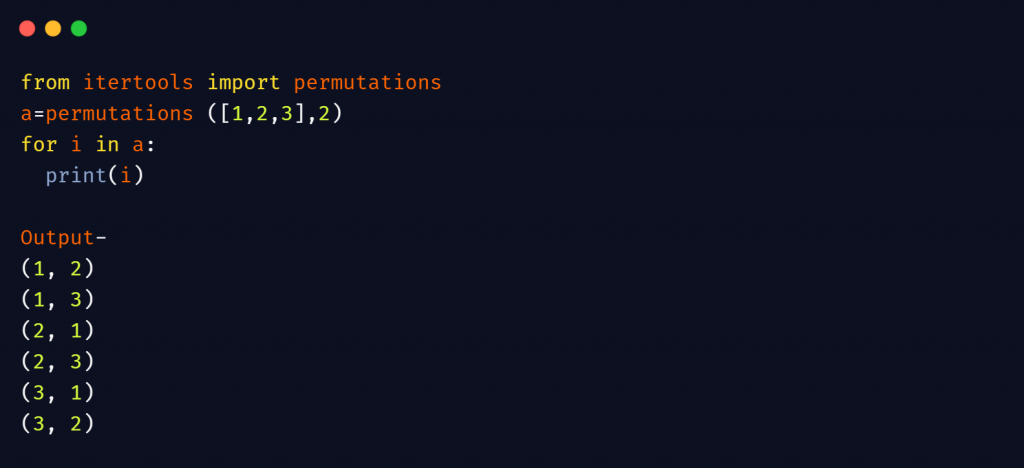
- Randomly permute python how to#
- Randomly permute python generator#
- Randomly permute python code#
The original array was of the shape (2,3,2,4).Īfter we shuffled its dimensions, it was transformed into the shape (2,4,3,2). Shuffled_indices = np.random.permutation(len(x)) #return a permutation of the indices While the shuffle method cannot accept more than 1 array, there is a way to achieve this by using another important method of the random module – np.random.permutation. Sometimes we want to shuffle multiple same-length arrays together, and in the same order.
Randomly permute python how to#
We saw how to shuffle a single NumPy array. In a later section, we will learn how to make these random operations deterministic to make the results reproducible. Your general idea was fine, np.zeros is often used to preallocate an array and fill it afterwards.
Randomly permute python code#
Note that the output you get when you run this code may differ from the output I got because, as we discussed, shuffle is a random operation. Yes, you can use np.zeros (rgbImg.shape), but there is an even more convenient way: np.zeroslike (rgbImg). import numpy as npĮach time we call the shuffle method, we get a different order of the array a. We will shuffle a 1-dimensional NumPy array. Let us look at the basic usage of the np.random.shuffle method. It can also be used to randomly sample items from a given set without replacement. Permutation refers to the arrangement of elements in an array. Shuffling operation is commonly used in machine learning pipelines where data are processed in batches.Įach time a batch is randomly selected from the dataset, it is preceded by a shuffling operation. The Random module in NumPy helps make permutations of elements of an array. It is particularly helpful in situations where we want to avoid any kind of bias to be introduced in the ordering of the data while it is being processed. The shuffling operation is fundamental to many applications where we want to introduce an element of chance while processing a given set of data.
6 Shuffle multidimensional NumPy arrays. 3 Shuffle multiple NumPy arrays together. # Pass the above given matrix as an argument to the random. Print("The given matrix is:\n", gvn_matx) # Print the above given matrix (multi-dimensional array) 
# number of rows and columns using the reshape() function # to get a list containing elements in given range and reshape it to given
Print the above-given matrix after permuting randomly. Pass the above given matrix as an argument to the random.permutation() function to randomly permute the elements of the above matrix. Print the above-given matrix (multi-dimensional array). Pass the lower and upper limit range as arguments to the arange() function to get a list containing elements in the given range and reshape it to the given number of rows and columns using the reshape() function. NP.random.permutation: When used with a multi-dimensional array, the function just permutes the items along the first axis. Print("The above given list after permuting:", rslt) # Print the above given list after permuting Lets take a look at what this looks like: Shuffle a list using random.shuffle()list Because the function works in-place, we do not need to reassign the. # to randomly permute the elements of the above list # Pass the above given list as an argument to the random.permutation() function # to get a list containing elements in given range(0 to 7 here) # Pass the lower and upper limit range as arguments to the arange() function  Print the above-given list after permuting randomly.īelow is the implementation: # Import numpy module using the import keyword. Pass the above given list as an argument to the random.permutation() function to randomly permute the elements of the above list. Pass the lower and upper limit range as arguments to the arange() function to get a list containing elements in the given range(0 to 7 here). Import numpy module using the import keyword. NumPy random.permutation() Function in Python Python NumPy random.random_sample() Function. If x is an integer, permute np.arange(x) at random.Ī permuted sequence or array range is returned The array or list to be shuffled is specified by this. if you do not pass any function as the second argument, it uses the function random.random(). The return value of this function fixes the order of shuffling. If x is a multidimensional array, only the first axis is shuffled. Specifically, you can pass the second argument of shuffle function a zero argument function which returns a value in 0, 1). Numpy random permutation: The permutation() function of the NumPy random module can randomly permute a sequence or return a permuted range.
Print the above-given list after permuting randomly.īelow is the implementation: # Import numpy module using the import keyword. Pass the above given list as an argument to the random.permutation() function to randomly permute the elements of the above list. Pass the lower and upper limit range as arguments to the arange() function to get a list containing elements in the given range(0 to 7 here). Import numpy module using the import keyword. NumPy random.permutation() Function in Python Python NumPy random.random_sample() Function. If x is an integer, permute np.arange(x) at random.Ī permuted sequence or array range is returned The array or list to be shuffled is specified by this. if you do not pass any function as the second argument, it uses the function random.random(). The return value of this function fixes the order of shuffling. If x is a multidimensional array, only the first axis is shuffled. Specifically, you can pass the second argument of shuffle function a zero argument function which returns a value in 0, 1). Numpy random permutation: The permutation() function of the NumPy random module can randomly permute a sequence or return a permuted range. Randomly permute python generator#
This module includes some basic random data generating methods, as well as permutation and distribution functions and random generator functions.

This module includes the functions for generating random numbers. NP random permutation: The random module is part of the NumPy library.







 0 kommentar(er)
0 kommentar(er)
